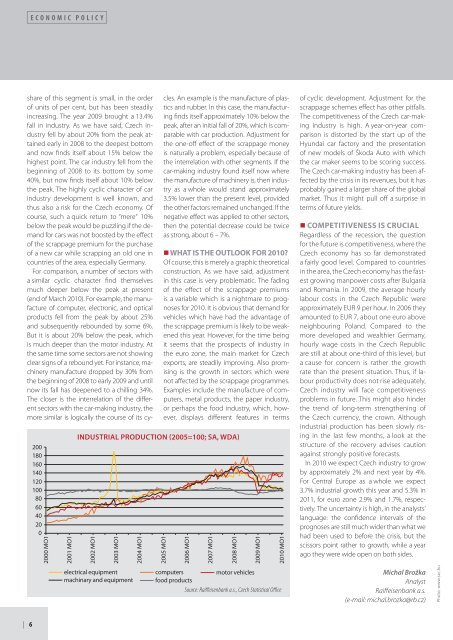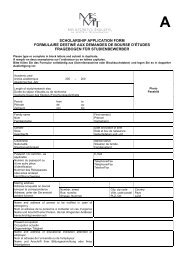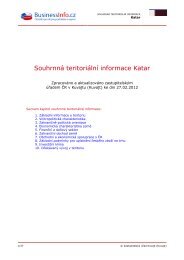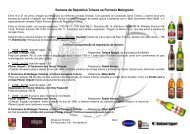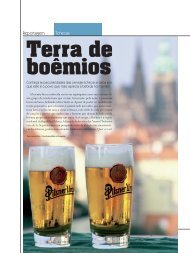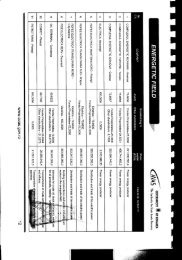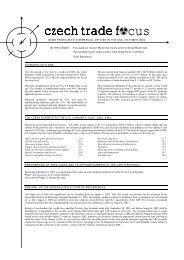czech pavilion at 2010 expo - MZV ÄŒR
czech pavilion at 2010 expo - MZV ÄŒR
czech pavilion at 2010 expo - MZV ÄŒR
You also want an ePaper? Increase the reach of your titles
YUMPU automatically turns print PDFs into web optimized ePapers that Google loves.
| 6<br />
ECONOMIC POLICY<br />
share of this segment is small, in the order<br />
of units of per cent, but has been steadily<br />
increasing. The year 2009 brought a 13.4%<br />
fall in industry. As we have said, Czech industry<br />
fell by about 20% from the peak <strong>at</strong>tained<br />
early in 2008 to the deepest bottom<br />
and now fi nds itself about 15% below the<br />
highest point. The car industry fell from the<br />
beginning of 2008 to its bottom by some<br />
40%, but now fi nds itself about 10% below<br />
the peak. The highly cyclic character of car<br />
industry development is well known, and<br />
thus also a risk for the Czech economy. Of<br />
course, such a quick return to “mere“ 10%<br />
below the peak would be puzzling if the demand<br />
for cars was not boosted by the eff ect<br />
of the scrappage premium for the purchase<br />
of a new car while scrapping an old one in<br />
countries of the area, especially Germany.<br />
For comparison, a number of sectors with<br />
a similar cyclic character fi nd themselves<br />
much deeper below the peak <strong>at</strong> present<br />
(end of March <strong>2010</strong>). For example, the manufacture<br />
of computer, electronic, and optical<br />
products fell from the peak by about 25%<br />
and subsequently rebounded by some 6%.<br />
But it is about 20% below the peak, which<br />
is much deeper than the motor industry. At<br />
the same time some sectors are not showing<br />
clear signs of a rebound yet. For instance, machinery<br />
manufacture dropped by 30% from<br />
the beginning of 2008 to early 2009 and until<br />
now its fall has deepened to a chilling 34%.<br />
The closer is the interrel<strong>at</strong>ion of the diff erent<br />
sectors with the car-making industry, the<br />
more similar is logically the course of its cy-<br />
200<br />
180<br />
160<br />
140<br />
120<br />
100<br />
80<br />
60<br />
40<br />
20<br />
0<br />
2000 MO1<br />
2001 MO1<br />
cles. An example is the manufacture of plastics<br />
and rubber. In this case, the manufacturing<br />
fi nds itself approxim<strong>at</strong>ely 10% below the<br />
peak, after an initial fall of 20%, which is comparable<br />
with car production. Adjustment for<br />
the one-off eff ect of the scrappage money<br />
is n<strong>at</strong>urally a problem, especially because of<br />
the interrel<strong>at</strong>ion with other segments. If the<br />
car-making industry found itself now where<br />
the manufacture of machinery is, then industry<br />
as a whole would stand approxim<strong>at</strong>ely<br />
3.5% lower than the present level, provided<br />
the other factors remained unchanged. If the<br />
neg<strong>at</strong>ive eff ect was applied to other sectors,<br />
then the potential decrease could be twice<br />
as strong, about 6 – 7%.<br />
� WHAT IS THE OUTLOOK FOR <strong>2010</strong>?<br />
Of course, this is merely a graphic theoretical<br />
construction. As we have said, adjustment<br />
in this case is very problem<strong>at</strong>ic. The fading<br />
of the eff ect of the scrappage premiums<br />
is a variable which is a nightmare to prognoses<br />
for <strong>2010</strong>. It is obvious th<strong>at</strong> demand for<br />
vehicles which have had the advantage of<br />
the scrappage premium is likely to be weakened<br />
this year. However, for the time being<br />
it seems th<strong>at</strong> the prospects of industry in<br />
the euro zone, the main market for Czech<br />
<strong>expo</strong>rts, are steadily improving. Also promising<br />
is the growth in sectors which were<br />
not aff ected by the scrappage programmes.<br />
Examples include the manufacture of computers,<br />
metal products, the paper industry,<br />
or perhaps the food industry, which, however,<br />
displays diff erent fe<strong>at</strong>ures in terms<br />
INDUSTRIAL PRODUCTION (2005=100; SA, WDA)<br />
2002 MO1<br />
2003 MO1<br />
electrical equipment<br />
machinary and equipment<br />
2004 MO1<br />
2005 MO1<br />
2006 MO1<br />
computers<br />
food products<br />
2007 MO1<br />
2008 MO1<br />
motor vehicles<br />
2009 MO1<br />
<strong>2010</strong> MO1<br />
Source: Raiff eisenbank a.s., Czech St<strong>at</strong>istical Offi ce<br />
of cyclic development. Adjustment for the<br />
scrappage schemes eff ect has other pitfalls.<br />
The competitiveness of the Czech car-making<br />
industry is high. A year-on-year comparison<br />
is distorted by the start up of the<br />
Hyundai car factory and the present<strong>at</strong>ion<br />
of new models of Škoda Auto with which<br />
the car maker seems to be scoring success.<br />
The Czech car-making industry has been affected<br />
by the crisis in its revenues, but it has<br />
probably gained a larger share of the global<br />
market. Thus it might pull off a surprise in<br />
terms of future yields.<br />
� COMPETITIVENESS IS CRUCIAL<br />
Regardless of the recession, the question<br />
for the future is competitiveness, where the<br />
Czech economy has so far demonstr<strong>at</strong>ed<br />
a fairly good level. Compared to countries<br />
in the area, the Czech economy has the fastest<br />
growing manpower costs after Bulgaria<br />
and Romania. In 2009, the average hourly<br />
labour costs in the Czech Republic were<br />
approxim<strong>at</strong>ely EUR 9 per hour. In 2006 they<br />
amounted to EUR 7, about one euro above<br />
neighbouring Poland. Compared to the<br />
more developed and wealthier Germany,<br />
hourly wage costs in the Czech Republic<br />
are still <strong>at</strong> about one-third of this level, but<br />
a cause for concern is r<strong>at</strong>her the growth<br />
r<strong>at</strong>e than the present situ<strong>at</strong>ion. Thus, if labour<br />
productivity does not rise adequ<strong>at</strong>ely,<br />
Czech industry will face competitiveness<br />
problems in future. This might also hinder<br />
the trend of long-term strengthening of<br />
the Czech currency, the crown. Although<br />
industrial production has been slowly rising<br />
in the last few months, a look <strong>at</strong> the<br />
structure of the recovery advises caution<br />
against strongly positive forecasts.<br />
In <strong>2010</strong> we expect Czech industry to grow<br />
by approxim<strong>at</strong>ely 2% and next year by 4%.<br />
For Central Europe as a whole we expect<br />
3.7% industrial growth this year and 5.3% in<br />
2011, for euro zone 2.9% and 1.7%, respectively.<br />
The uncertainty is high, in the analysts‘<br />
language: the confi dence intervals of the<br />
prognoses are still much wider than wh<strong>at</strong> we<br />
had been used to before the crisis, but the<br />
scissors point r<strong>at</strong>her to growth, while a year<br />
ago they were wide open on both sides.<br />
Michal Brožka<br />
Analyst<br />
Raiff eisenbank a.s.<br />
(e-mail: michal.brozka@rb.cz)<br />
Photo: www.sxc.hu


